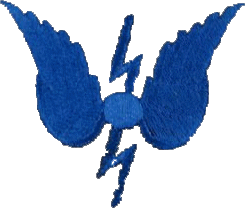|
|
|
|
|
FREQUENCY RANGE | |
1. 64T Design A - 6 - 7.5 Mc/s.
2. 64T Design B - 7.5 - 9 Mc/s.
3. 64MT Design A - 6 - 7.5 Mc/s.
4. 64MT Design B - 7.5 - 9 Mc/s.
5. 64PT Design C - 6 - 7.5 Mc/s.
6. 64PT Design D - 7.5 - 9 Mc/s. |
|
METHOD OF USE | |
1. 64T Design A - Transmitter container fitted with rucksack carrying frame and operated from dry batteries fitted inside transmitter.
2. 64T Design B - Transmitter container fitted with rucksack carrying frame and operated from dry batteries fitted inside transmitter.
3. 64MT Design A - Transmitter container fitted with straps to enable it to be packed in a parachute container and operated from dry batteries fitted inside the transmitter.
4. 64MT Design B - Transmitter container fitted with straps to enable it to be packed in a parachute container and operated from dry batteries fitted inside the transmitter.
5. 64PT Design C - Transmitter container fitted with rucksack carrying frame and operated from a 12V Accumulator or hand driven generator supplying 12V, carried separately from the transmitter. In this case, the HT supply is obtained from a vibrator fitted inside the transmitter container.
6. 64PT Design D - Transmitter container fitted with rucksack carrying frame and operated from a 12V Accumulator or hand driven generator supplying 12V, carried separately from the transmitter. In this case, the HT supply is obtained from a vibrator fitted inside the transmitter container. |
|
WEIGHTS. | |
1. 64T Design A - Transmitter with batteries = 29lbs. Aerial gear = 5lbs.
2. 64T Design B - Transmitter with batteries = 29lbs. Aerial gear = 5lbs.
3. 64MT Design A - Transmitter with batteries = 31lbs. Aerial gear = 5lbs.
4. 64MT Design B - Transmitter with batteries = 31lbs. Aerial gear = 5lbs.
5. 64PT Design C - Transmitter = 27lbs. Aerial gear = 5lbs. Hand driven generator = 16lbs.Accumulator battery = 16lbs.
6. 64PT Design D - Transmitter = 27lbs. Aerial gear = 5lbs. Hand driven generator = 16lbs.Accumulator battery = 16lbs. |
|
RANGE | |
The set had a reliable working range of 3 miles although 10 miles under favourable conditions was practicable. See Photos to see what the transmitter looked like. |
|
FURTHER READING | |
|
|
IMAGES, PHOTOS, DOCUMENTS, SCHEMATICS ETC. | |
|
|
NOTES. | |
Perhaps the most important feature is the CLOCK. This is fitted to enable the time at which the transmitter is switched on to be preset within the limits 0-48 hours (see clock face dial). In addition to switching the transmitter on it also provides automatic keying of the transmitter. A special 'code letter' is transmitted, the 'code letter' being determined by a small cam which can be interchanged at will. Six cams are provided which give a DASH of approximately 7 seconds duration when a standard clock is used. In a large number of sets the clock mechanism has been slowed down, giving the length of "homing" dash approximately 11 to 13 seconds. The length of a DOT in Morse code becomes in this case, 1 second approximately and the length of a DASH in Morse code 3 seconds approximately. The set of code cams contains the following 'code letters' : A, B, D, N, U and V. Thus, assuming that a 'mission' has been assigned the 'code letter' U, the automatically transmitted signal is:-
DOT DOT DASH HOMING SIGNAL followed by a four seconds before the signal repeats itself. This is a total of:-
1 sec (dot) 1 sec (space) 1 sec (dot) 1 sec (space) 3 secs (dash) 1 sec (space) 12 secs (homing dash) 4 secs (space) = 24 seconds.
There were three ways to send the 'homing dash' and 'code letter'.
(a)
(i) That the cam should not be allowed to operate and that the clock dial should be removed from the transmitter.
(ii) The filament switch should be pressed manually by hand.
(iii) A Morse key should be provided to send the "beacon" signal by hand.
(iv) The filament switch should be turned off manually when not sending manual Morse code.
(b) Automatic. Wind the clock up fully. Push the securing lever radially then let it fall down. Clock mechanism will rotate and send the 'code letter' automatically.
(c) Automatically. Wind the clock up fully. Set the dial on the shaft so that the starting lever is pointing to zero. The adjustment pointer (trip lever) should be set so that the following or longer edge indicates the desired time of the start of transmission. In the drawing of the clock above, you will see that it has been set to start transmitting 6 HOURS after setting, namely the longest edge of the trip lever is on figure 6.
The length of time the transmitter will send the homing signal, assuming the batteries are new, is FOUR HOURS. However, if a long time is known to be required, either two separate sets should be deployed, or a shift to manual Morse should be contemplated, sending the homing signal say, for five minutes every half hour. DOT DOT DASH 12 SECONDS HOMING DASH
The signal emitted is MCW so that any receiver can demodulate its signal. |


